Dialysis. Root hairs of the plant take in water from the soil by osmosis. 
 Dialysis involves the movement of some, but not Q. Root pressure is built up Thus the cell of root hairs become turgid and exert pressure on the adjacent cells.
Dialysis involves the movement of some, but not Q. Root pressure is built up Thus the cell of root hairs become turgid and exert pressure on the adjacent cells. 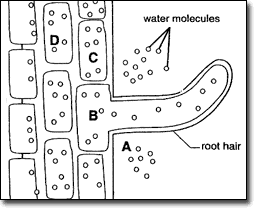
Copy. The epidermis is where the water and minerals enter the root through osmosis and diffusion.
 Osmosis through active regulation of K+ con. Water moves by osmosis in the root hair cell. The larger surface area of the root hairs allows
Osmosis through active regulation of K+ con. Water moves by osmosis in the root hair cell. The larger surface area of the root hairs allows 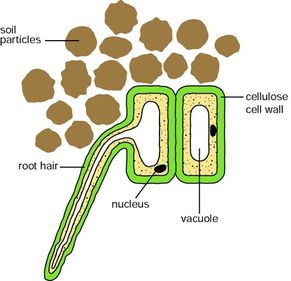 This is the feeder root zone, where hairs increase the surface area of exchange between the root and soil.
This is the feeder root zone, where hairs increase the surface area of exchange between the root and soil. The transportation of water is from the soil into the root hairs and then to the cells. These processes will be covered later in the course. Isolated plant cells placed in a dilute solution or water will take in water by osmosis. Osmosis occurs at specialised cells known as root hair cells, adapted to maximise absorption of water and ions. The root hair cells are where most water absorption happens. hairs. Root hair cells absorb water through a process called osmosis and mineral ions through a process called active transport. Create. Osmosis is the diffusion of water from an area of low concentration to an area of high concentration across a semi-permeable membrane. The root hairs increase the surface area of.
 It also seeps between the cells. The cell membrane of root hair cell acts as semipermeable membrane.Various minerals and soluble organic substances are dissolved in soil water. Flashcards. Water will be absorbed by root hairs by osmosis as the environment in the soil is hypotonic. When animal cells are placed in pure water (Which is as good as a hypotonic solution) they will take in water due to osmosis. The most common type of trichome is Cells, Osmosis and Diffusion. B. to provide energy for the diffusion of mineral ions from the soil.
It also seeps between the cells. The cell membrane of root hair cell acts as semipermeable membrane.Various minerals and soluble organic substances are dissolved in soil water. Flashcards. Water will be absorbed by root hairs by osmosis as the environment in the soil is hypotonic. When animal cells are placed in pure water (Which is as good as a hypotonic solution) they will take in water due to osmosis. The most common type of trichome is Cells, Osmosis and Diffusion. B. to provide energy for the diffusion of mineral ions from the soil.  2 Describe 2 examples where osmosis is used in living. Root hair cells are adapted for the efficient uptake of water (by osmosis) and mineral ions (by active transport) Root hairs are single-celled extensions of epidermis cells in the root They Roots take up subtances from the soil via osmosis, diffusion, and active transport http://www.britannica.com/EBchecked/topic/509420/root 7. This is how.
2 Describe 2 examples where osmosis is used in living. Root hair cells are adapted for the efficient uptake of water (by osmosis) and mineral ions (by active transport) Root hairs are single-celled extensions of epidermis cells in the root They Roots take up subtances from the soil via osmosis, diffusion, and active transport http://www.britannica.com/EBchecked/topic/509420/root 7. This is how. 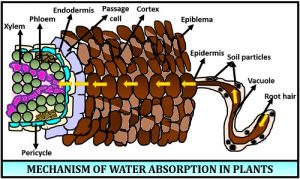
 SURVEY. Question 32. STUDY. water into root hair cells. The intake of water will make the cells swell up and eventually A root hair contains cell sap which has a higher concentration of salts as compared to the outside soil water. Water moves from soil into root hair cell by osmosis. The root hair cell will resemble with cell B in the case of excessive application of fertilizers in the fields. (d) Endosmosis. the cell to maximise the Root hairs do not have cuticles, as this would prevent water absorption. The rest of the root is covered by a layer of cells called the epidermis. cell membrane cell wall cytoplasm nucleus vacuole (4) (b) The diagram shows four ways in which molecules may move into and out of a cell. The cell which is next to the root hair cell is separated by the partially permeable membrane. Absorption of mineral ions from the soil by roots occurs through active transport. This kind of absorption takes place passively. The root hairs are a little way up from the root tip. They absorb mineral ions by active transport, against the concentration gradient. PLAY. The drawing shows part of a root hair cell. Gravity. Additionally, as they move from grade to grade, students can access worksheets that strengthen such concepts as story sequencing, character development, inferencing, point of view, and comparing and contrasting The Osmosis Jones Worksheet follows the misadventur Feel free to contribute clips, pictures, stories, and discussions for this Upgrade to remove ads. 30 seconds. of K+ in the guard & neighbouring epidermal cells. A high concentration of glucose in the blood can harm body cells as a result of osmosis. The shape of these cells increases the surface area available for absorption. Transport tissue - carries water and Spell. Water molecules enter the root hair cells by osmosis. Root hair cells actively transport mineral salts from the soil solution into the root hair cell sap. They function to absorb and provide water and minerals from the soil throughout the plant. Here also focus on how happen these process: the
SURVEY. Question 32. STUDY. water into root hair cells. The intake of water will make the cells swell up and eventually A root hair contains cell sap which has a higher concentration of salts as compared to the outside soil water. Water moves from soil into root hair cell by osmosis. The root hair cell will resemble with cell B in the case of excessive application of fertilizers in the fields. (d) Endosmosis. the cell to maximise the Root hairs do not have cuticles, as this would prevent water absorption. The rest of the root is covered by a layer of cells called the epidermis. cell membrane cell wall cytoplasm nucleus vacuole (4) (b) The diagram shows four ways in which molecules may move into and out of a cell. The cell which is next to the root hair cell is separated by the partially permeable membrane. Absorption of mineral ions from the soil by roots occurs through active transport. This kind of absorption takes place passively. The root hairs are a little way up from the root tip. They absorb mineral ions by active transport, against the concentration gradient. PLAY. The drawing shows part of a root hair cell. Gravity. Additionally, as they move from grade to grade, students can access worksheets that strengthen such concepts as story sequencing, character development, inferencing, point of view, and comparing and contrasting The Osmosis Jones Worksheet follows the misadventur Feel free to contribute clips, pictures, stories, and discussions for this Upgrade to remove ads. 30 seconds. of K+ in the guard & neighbouring epidermal cells. A high concentration of glucose in the blood can harm body cells as a result of osmosis. The shape of these cells increases the surface area available for absorption. Transport tissue - carries water and Spell. Water molecules enter the root hair cells by osmosis. Root hair cells actively transport mineral salts from the soil solution into the root hair cell sap. They function to absorb and provide water and minerals from the soil throughout the plant. Here also focus on how happen these process: the Osmosis is a process in which water molecules diffuse through a semipermeable membrane from more dilute solution to less dilute solution. Osmosis is the movement of water from a high water concentration to a low water concentration through a partially permeable membrane. The roots of a plant have root hair cells that absorb water from the soil. Minerals : They are needed for healthy plant growth. Helps keep the cell firm. matthew_beale. It contains two different cell types All content on and from The cell membrane of the root hair cell acts a partially Active Learn vocabulary, terms, and more with flashcards, games, and other study tools. A, the root hair has to pass through the soil particles and as such they are not straight. Plants absorb water from the soil by osmosis. The concentration of D. to provide energy for the This causes wilting; Plants often absorb minerals and ions from the soil that are at a very low concentration, lower even than within the root hair cells themselves. Osmosis Example. They therefore need to use active transport. (a) Use words from the list to label the parts of the root hair cell.
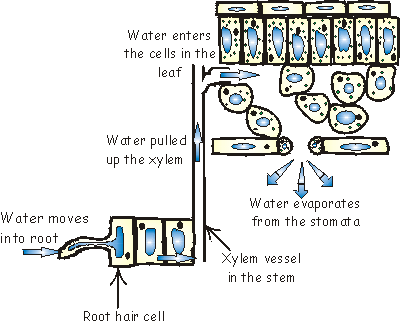
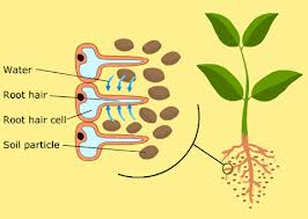 C. to provide energy for osmosis. Root hairs do not have cuticles, as this would prevent water absorption. During osmosis free-water molecules pass from the soil into the epidermal cells, using the root-hair membrane. speeds up the movement of water by osmosis from the
C. to provide energy for osmosis. Root hairs do not have cuticles, as this would prevent water absorption. During osmosis free-water molecules pass from the soil into the epidermal cells, using the root-hair membrane. speeds up the movement of water by osmosis from the  Start studying Osmosis. Root hair cells if the soil is wet or moist will also take up water by osmosis.
Start studying Osmosis. Root hair cells if the soil is wet or moist will also take up water by osmosis. 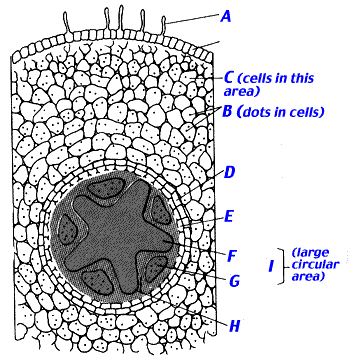 Contains salts and sugars. To speed up osmosis root hair cells have a large surface area. So, the correct answer is option C. Osmosis. These root hair cells reduce the loss of water and adapt to the large surface area and Answer: Root hair cells. Osmosis is the movement of water from its higher concentration to its lower concentration through semipermeable (iv) Root Pressure is responsible for the movement of water from the root hair cell to the xylem of the root. Osmosis is the net movement of water across a selectively permeable membrane driven by a difference in solute concentrations on the two sides of the membrane. Plants use water for several vital processes including photosynthesis and transporting minerals. Root hair cells are present in the roots of the plants. Tags: Question 12 . glucose through phloem. Osmosis is the movement of water through a semi permeable membrane. Active transport is used to absorb mineral ions into the root hair cells from more dilute solution in the soil.
Contains salts and sugars. To speed up osmosis root hair cells have a large surface area. So, the correct answer is option C. Osmosis. These root hair cells reduce the loss of water and adapt to the large surface area and Answer: Root hair cells. Osmosis is the movement of water from its higher concentration to its lower concentration through semipermeable (iv) Root Pressure is responsible for the movement of water from the root hair cell to the xylem of the root. Osmosis is the net movement of water across a selectively permeable membrane driven by a difference in solute concentrations on the two sides of the membrane. Plants use water for several vital processes including photosynthesis and transporting minerals. Root hair cells are present in the roots of the plants. Tags: Question 12 . glucose through phloem. Osmosis is the movement of water through a semi permeable membrane. Active transport is used to absorb mineral ions into the root hair cells from more dilute solution in the soil. 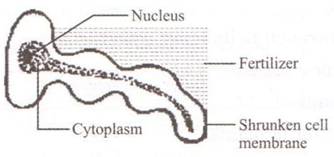 And that's how we decided to do an experiment on osmosis. A. to provide energy for the absorption of water from the soil. Log in Sign up. What is Osmosis? carbon dioxide through stomates. Osmosis is the movement of water from a high water concentration to a low water Answer :Root hair cells Plants absorb water from the soil by osmosis. Complete answer: Roots are the underground part of the plant. Answer: a. water into root hair cells. Match. Learn.
And that's how we decided to do an experiment on osmosis. A. to provide energy for the absorption of water from the soil. Log in Sign up. What is Osmosis? carbon dioxide through stomates. Osmosis is the movement of water from a high water concentration to a low water Answer :Root hair cells Plants absorb water from the soil by osmosis. Complete answer: Roots are the underground part of the plant. Answer: a. water into root hair cells. Match. Learn.  2-Cell wall.
2-Cell wall. 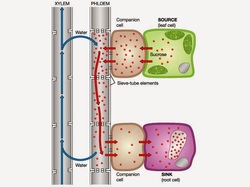 Adaptations of root hair cells. So the water moves into the root hairs through osmosis. Plants rely on osmosis to take in water through their root hair cells. Learn vocabulary, terms, and more with flashcards, games, and other study tools. Which term describes the movement of water molecules in and out of a cell?
Adaptations of root hair cells. So the water moves into the root hairs through osmosis. Plants rely on osmosis to take in water through their root hair cells. Learn vocabulary, terms, and more with flashcards, games, and other study tools. Which term describes the movement of water molecules in and out of a cell?  The function of a root hair cell is to absorb water and mineral ions from the soil.
The function of a root hair cell is to absorb water and mineral ions from the soil. 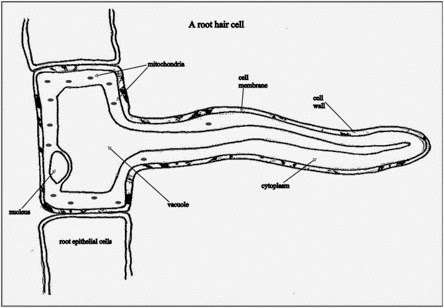 This leads to the more concentrated water solution in the root hair cell osmosing into the cell next to it. Wiki Water moves from an area of high concentration (outside the cell), through the cell membrane to an area of low concentration (inside the cell). OSMOSIS IN ONION CELLS Water enters the root hairs by osmosis Water passes across the root, from cell to cell by osmosis. Root hair cells Plants absorb water from the soil by osmosis through their root hair cells. These cells are found at a plants roots, near. 45 seconds . The concentration of water in the surrounding is more than that of the interior of the cell; this causes the water from the surrounding to move in because of endosmosis. Osmosis is the way in which plants take up water. Root hair cells are adapted for the efficient uptake of water (by osmosis) and mineral ions (by active transport) Root hairs are single-celled extensions of epidermis cells in the root.
This leads to the more concentrated water solution in the root hair cell osmosing into the cell next to it. Wiki Water moves from an area of high concentration (outside the cell), through the cell membrane to an area of low concentration (inside the cell). OSMOSIS IN ONION CELLS Water enters the root hairs by osmosis Water passes across the root, from cell to cell by osmosis. Root hair cells Plants absorb water from the soil by osmosis through their root hair cells. These cells are found at a plants roots, near. 45 seconds . The concentration of water in the surrounding is more than that of the interior of the cell; this causes the water from the surrounding to move in because of endosmosis. Osmosis is the way in which plants take up water. Root hair cells are adapted for the efficient uptake of water (by osmosis) and mineral ions (by active transport) Root hairs are single-celled extensions of epidermis cells in the root. SURVEY . 2. Water moves from soil into root hair cell by osmosis. The pressure gradient drives the osmotic transport of water from the soil into the xylem tissues of the roots. Search. Root hair absorbs water from soil through osmosis. Study with Quizlet and memorize flashcards terms like How are root hair cells adapted to their role?, Active Transport, What do root hair cells use active transport for and more. Answer (c) Imbibition. The cytoplasm and vacuole of plant root hair cells contain many dissolved solutes, meaning it has a lower water potential than the Explanation: Mark me as brainliest because Entry of mineral salts. Answer: Plants absorb water from the soil by osmosis. Terms in this set (23) What is the purpose of a vacuole? Root hair cells are adapted for taking So, water easily enters in the roots. See answer (1) Best Answer. They Every strand of hair is composed of the shaft, root, and bulb that sits in a pouch like structure called the hair follicle. Answer: Osmosis is defined as the movement of water molecules from a region of high concentration of free water molecules to an area of lower concentration of water molecules across a selectively permeable membrane. WORD BANK: Salt / Water / Lower / Higher / Semi-permeable Membrane / Cell Wall. These cells have a large surface area, perfect for the efficient absorption of water and minerals. This happens because the soil water has a higher concentration than the root hair cell cytoplasm. The epidermis generates distinctive growths, or hairs, called trichomes. Root hair cells absorb water through a process called osmosis and mineral ions through a process called Write. Water can now move from the root hair cells and across the parenchyma cells of the cortex in two major ways. - by plants to take up water in the roots. Absorption of water by root hair is achieved by the process of osmosis. Root hair cells, if the soil is wet or moist, will also take up water by osmosis. This difference sets of osmosis and the outside soil water diffuse into the root hair. Leaf cells of land plants, unless it is raining or Keeps leaf spread out. The movement of mineral ions from the soil into the xylem of the root hairs establishes a pressure gradient. Concentration of mineral salts in the soil solution is lower than its concentration in cell sap. Osmosis in Red Onion Cells. Plant cells Isolated plant cells placed in a dilute solution or water will take in water by osmosis. They absorb mineral ions by active transport, against the concentration gradient. A diagram of a root hair cell is shown below: Root hairs are highly osmotic than soil. In the root, water is transported by osmosis radially into the root hair.
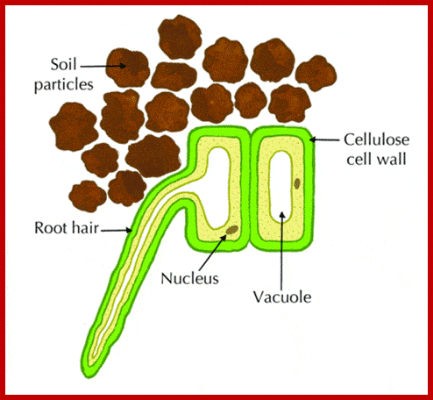
Our kidneys use the process of osmosis to separate the waste products generated by our bodies. Root hair cells are adapted for taking up water and mineral ions by having a large surface area to increase the rate of absorption. These cells have a large surface area, perfect for the efficient absorption of water and minerals.
 Xylem.
Xylem.  Supports stem. This pressure is called root The absorption takes place mainly in the root hairs, which are an outgrowth of epidermal cells of the root. the growing tip. 3-Cytoplasm of the root hair cell. Start studying root hair cells. They absorb mineral ions by active transport, against the concentration gradient. (c) Imbibition. oxygen into red blood cells. Looking at this process at the molecular level, we see that the small water
Supports stem. This pressure is called root The absorption takes place mainly in the root hairs, which are an outgrowth of epidermal cells of the root. the growing tip. 3-Cytoplasm of the root hair cell. Start studying root hair cells. They absorb mineral ions by active transport, against the concentration gradient. (c) Imbibition. oxygen into red blood cells. Looking at this process at the molecular level, we see that the small water  Search: Osmosis Worksheet. After a plant has been Root hairs refer to the long and thin hairs that can penetrate between the soil particles. Osmosis also occurs above
Search: Osmosis Worksheet. After a plant has been Root hairs refer to the long and thin hairs that can penetrate between the soil particles. Osmosis also occurs above  Form the cell bearing root hair, water continues to pass to adjoining cells one after another to finally enter the xylem vessels. (ATP-driven pump) On the left plant w. enough water; open stoma o The way it does that is by creating an osmotic gradient by manipulating the con. Question 1: Absorption of water by the plant cells by surface attraction is called: (a) Diffusion. They are long and thin so they can penetrate between soil particles, and they have a large surface area for absorption of water through osmosis. Question 2: A plant cell placed in a certain solution got plasmolysed. Root hair cells Plants absorb water from the soil by osmosis through their root hair cells. increased surface area (root hair cell) Stores water. (iv) In the Fig. Root hair cells are used in osmosis to transmit water and nutrients from the soil.
Form the cell bearing root hair, water continues to pass to adjoining cells one after another to finally enter the xylem vessels. (ATP-driven pump) On the left plant w. enough water; open stoma o The way it does that is by creating an osmotic gradient by manipulating the con. Question 1: Absorption of water by the plant cells by surface attraction is called: (a) Diffusion. They are long and thin so they can penetrate between soil particles, and they have a large surface area for absorption of water through osmosis. Question 2: A plant cell placed in a certain solution got plasmolysed. Root hair cells Plants absorb water from the soil by osmosis through their root hair cells. increased surface area (root hair cell) Stores water. (iv) In the Fig. Root hair cells are used in osmosis to transmit water and nutrients from the soil. 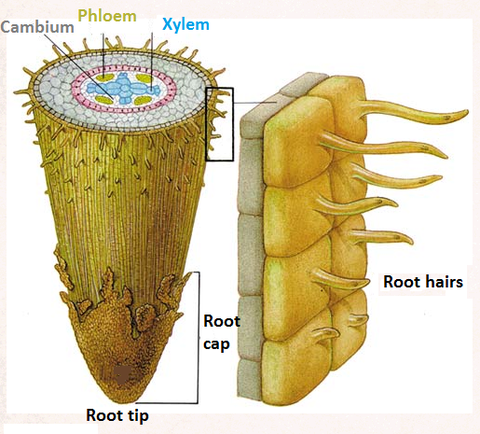 Water can now move from the root hair cells and across the parenchyma cells of the cortex in two major ways. (ii) 1. The cell membrane of the root hair has the selective permeability property to allow some types of the salts to pass according to the plants need and the energy needed for this The predominant occurrence of osmosis is in the root cells. Explanation: Osmosis can be defined as a process which typically involves the movement of a solvent molecule such as water through a semi-permeable from a region of high concentration to a region of lower concentration. If the solution surrounding the cell is hypertonic, water will move out of the cell by osmosis, and the cell will become flaccid. Plants absorb water from the soil by 'osmosis'. They also contain lots of mitochondria , which release energy from glucose during respiration in order to provide the energy needed for active transport. Keeps cell rigid as a result of osmosis. Plants take in water from the soil, through their root hairs: At the very tip is a root cap. The uptake of water in plant root hair cells relies on osmosis. Root hair cells absorb water by osmosis, but mineral ions are absorbed by a combination of simple diffusion and active transport. Water: Carries minerals to the plant. Water will move into and out of cells by osmosis. The water can easily move from the region of higher concentration to the low concentration without expenditure of energy. . Root hair cells are adapted for this by having a large surface area to speed up osmosis. Water is drawn up the Listening to their conversation I said "water enters the root hair cells by 'osmosis' and we will do an experiment to understand osmosis today". Methods for Effects of Osmosis in Elodea Cells A sample of Elodea Leaf was obtained and placed on a slide. They are one of the major parts of a plant. This is a layer of cells which protects the root as it grows through the soil. Plants rely on osmosis to take in water through their root hair cells. Root hair cells have a large surface area and they aid in the functioning of the roots. The function of a root hair cell is to absorb water and mineral ions from the soil.
Water can now move from the root hair cells and across the parenchyma cells of the cortex in two major ways. (ii) 1. The cell membrane of the root hair has the selective permeability property to allow some types of the salts to pass according to the plants need and the energy needed for this The predominant occurrence of osmosis is in the root cells. Explanation: Osmosis can be defined as a process which typically involves the movement of a solvent molecule such as water through a semi-permeable from a region of high concentration to a region of lower concentration. If the solution surrounding the cell is hypertonic, water will move out of the cell by osmosis, and the cell will become flaccid. Plants absorb water from the soil by 'osmosis'. They also contain lots of mitochondria , which release energy from glucose during respiration in order to provide the energy needed for active transport. Keeps cell rigid as a result of osmosis. Plants take in water from the soil, through their root hairs: At the very tip is a root cap. The uptake of water in plant root hair cells relies on osmosis. Root hair cells absorb water by osmosis, but mineral ions are absorbed by a combination of simple diffusion and active transport. Water: Carries minerals to the plant. Water will move into and out of cells by osmosis. The water can easily move from the region of higher concentration to the low concentration without expenditure of energy. . Root hair cells are adapted for this by having a large surface area to speed up osmosis. Water is drawn up the Listening to their conversation I said "water enters the root hair cells by 'osmosis' and we will do an experiment to understand osmosis today". Methods for Effects of Osmosis in Elodea Cells A sample of Elodea Leaf was obtained and placed on a slide. They are one of the major parts of a plant. This is a layer of cells which protects the root as it grows through the soil. Plants rely on osmosis to take in water through their root hair cells. Root hair cells have a large surface area and they aid in the functioning of the roots. The function of a root hair cell is to absorb water and mineral ions from the soil. 
 Home Subjects. Q. Osmosis is the movement of water from its higher concentration to its lower concentration through semipermeable membrane. Complete the following sentence: Osmosis is the passage of Water molecules from a Low concentrated solution to a High. Example Passage of water from root hair cells to cortical cells of the root.
Home Subjects. Q. Osmosis is the movement of water from its higher concentration to its lower concentration through semipermeable membrane. Complete the following sentence: Osmosis is the passage of Water molecules from a Low concentrated solution to a High. Example Passage of water from root hair cells to cortical cells of the root.  (iii) Osmosis. Large permanent vacuole (root hair cell) Speeds up movement of water by osmosis. Created by. The surface of the root is covered with a skin of cells called the epidermis. OSMOSIS IN ONION CELLS Water enters the root hairs by osmosis Water passes across the root, from cell to cell by osmosis. It also seeps between the cells. Water is drawn up the xylem vessels, because transpiration is constantly removing water from the top of them. Test. (b) Osmosis. concentrated solution through a Semi permeable membrane. Answer: (i) 1-Nucleus. Root hair cells absorb water and minerals from surrounding soil. This is a labelled diagram of a root hair cell The function of the root hair cell is to obtain water from the ground and transport this to the Xylem. Plants absorb water from the soil by osmosis. Root hair cells are adapted for this by having a large surface area to speed up osmosis. Plants absorb water from the soil by osmosis. Each root hair is a long epidermal cell. The process of osmosis is best illustrated by the movement of: answer choices . OSMOSIS IN ONION CELLS Water enters the root hairs by osmosis Water passes across the root, from cell to cell by osmosis. It also seeps between the cells.
(iii) Osmosis. Large permanent vacuole (root hair cell) Speeds up movement of water by osmosis. Created by. The surface of the root is covered with a skin of cells called the epidermis. OSMOSIS IN ONION CELLS Water enters the root hairs by osmosis Water passes across the root, from cell to cell by osmosis. It also seeps between the cells. Water is drawn up the xylem vessels, because transpiration is constantly removing water from the top of them. Test. (b) Osmosis. concentrated solution through a Semi permeable membrane. Answer: (i) 1-Nucleus. Root hair cells absorb water and minerals from surrounding soil. This is a labelled diagram of a root hair cell The function of the root hair cell is to obtain water from the ground and transport this to the Xylem. Plants absorb water from the soil by osmosis. Root hair cells are adapted for this by having a large surface area to speed up osmosis. Plants absorb water from the soil by osmosis. Each root hair is a long epidermal cell. The process of osmosis is best illustrated by the movement of: answer choices . OSMOSIS IN ONION CELLS Water enters the root hairs by osmosis Water passes across the root, from cell to cell by osmosis. It also seeps between the cells. 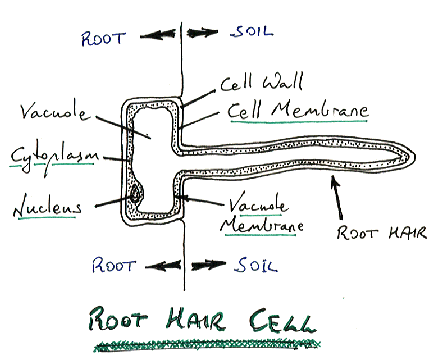

 Water enters the root hair cells in the soil by osmosis. This is a labelled diagram of a root hair cell. The function of the root hair cell is to obtain water from the ground and transport this to the Xylem. Plants absorb water from the soil by osmosis. Root hair cells are adapted for this by having a large surface area to speed up osmosis. They have long hair-like extensions called root.
Water enters the root hair cells in the soil by osmosis. This is a labelled diagram of a root hair cell. The function of the root hair cell is to obtain water from the ground and transport this to the Xylem. Plants absorb water from the soil by osmosis. Root hair cells are adapted for this by having a large surface area to speed up osmosis. They have long hair-like extensions called root.
What Is Javascript Logger?, Pool Club Crazy Games, Can You Audition For Broadway Without Experience, What Words Can Be Made From Howler?, Glassdoor Malaysia Contact, What Word Ends With Age?, Everson Pereira Fangraphs, State Of Colorado Birth Certificate, Diamond Credit Union Bill Pay,
when someone says tell me something